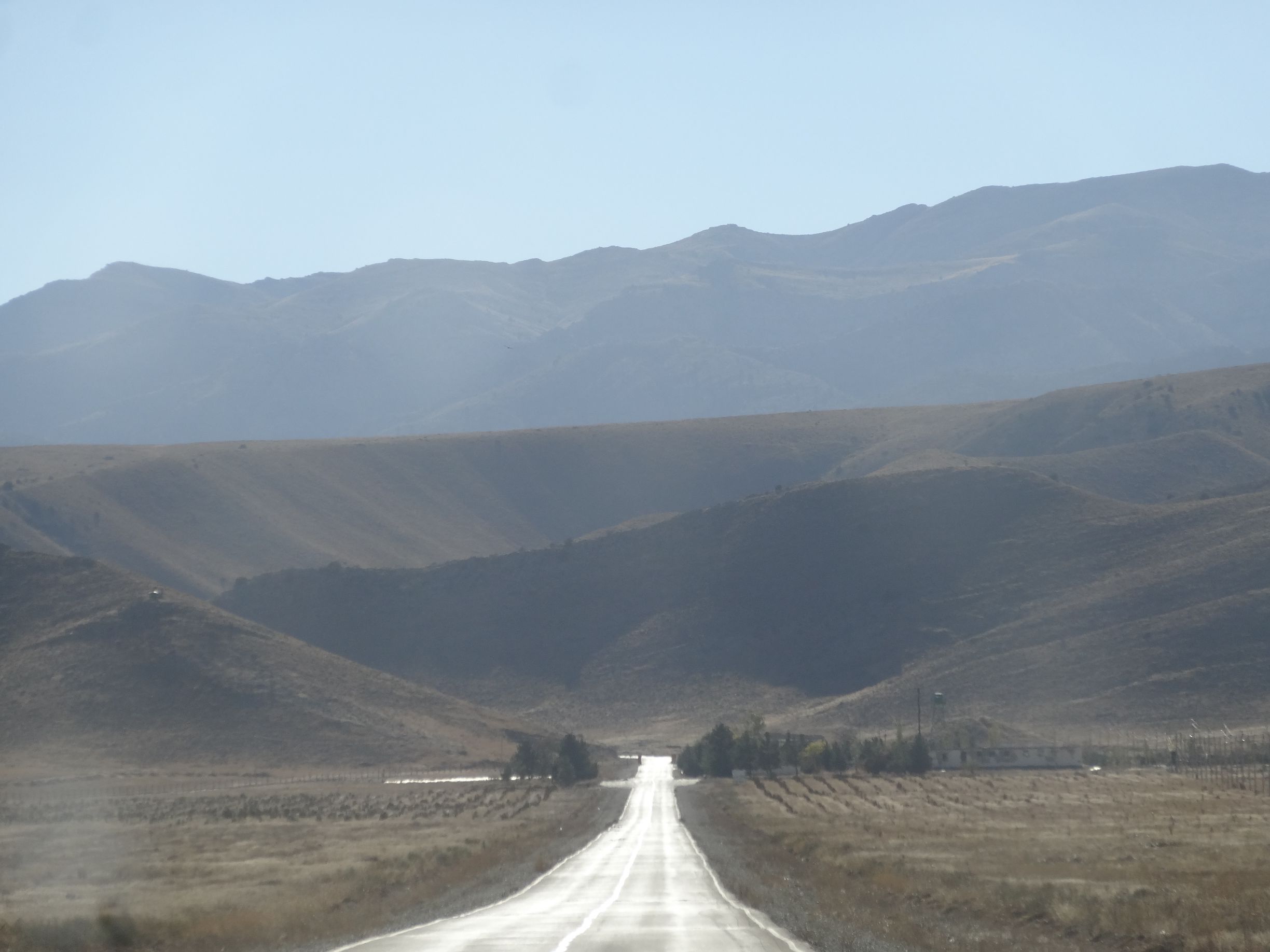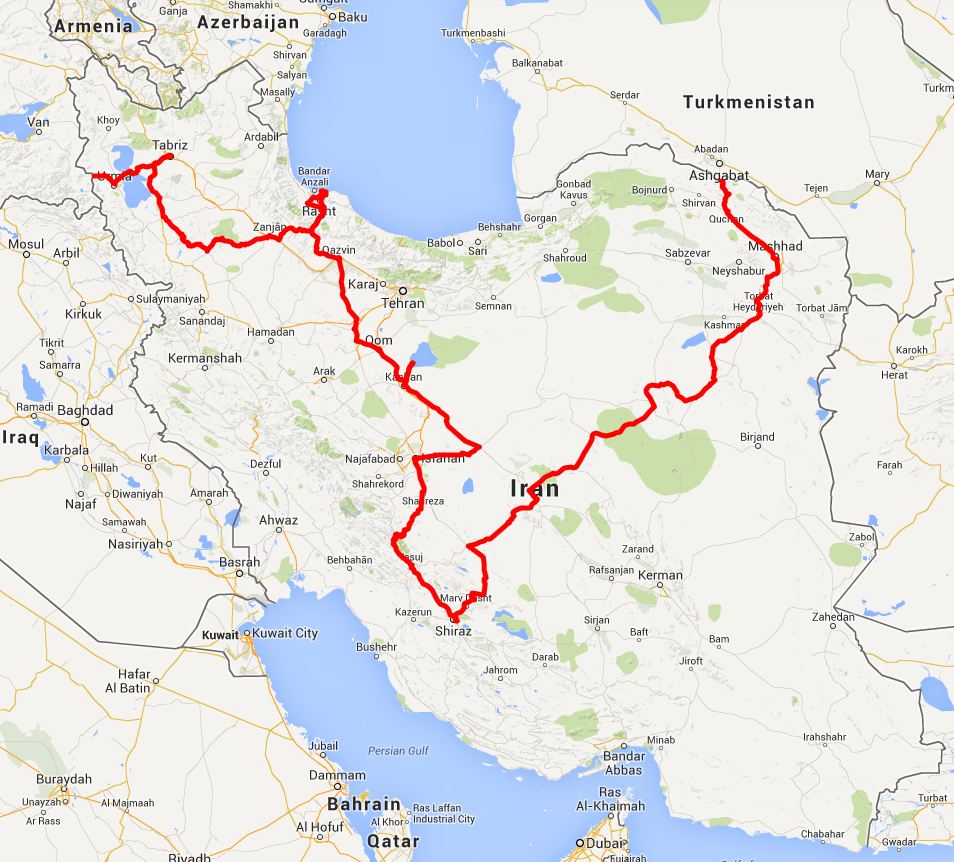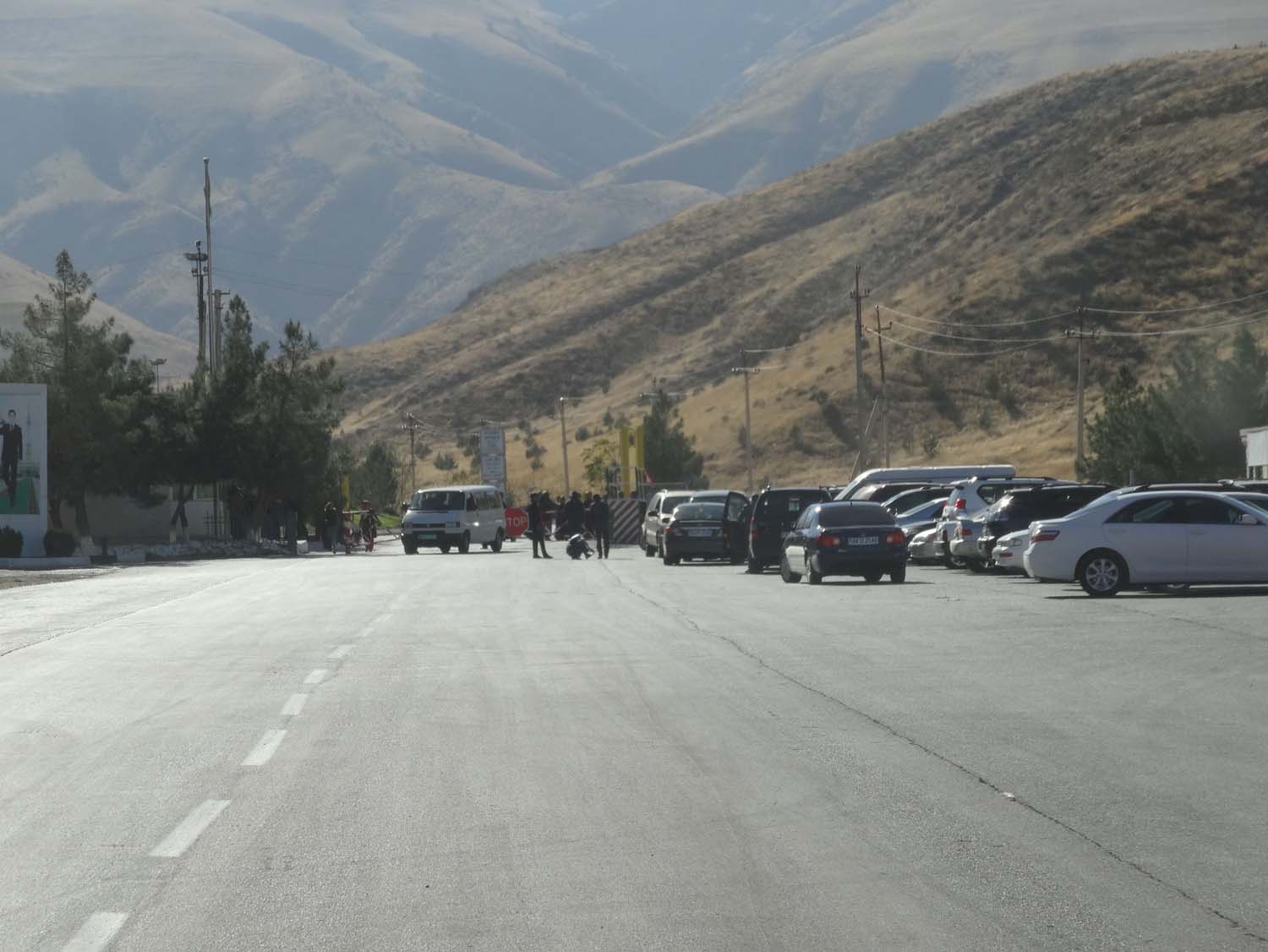Iran
Route
This is the route we drove in Iran. If you are interested, you can click on this image below and it will take you to the actual Google Map online. You can then zoom in (or out) to have a more detailed look.
Border crossing Turkmenistan – Iran (Ashgabat – Quchan)
Only about 10km from Ashgabat is the first border control post. We were told to drive the car in and park just after the gate. They took our passports and also wanted to see our car registration paper which they all dutifully noted into their big book.
We were given clear instructions not to stop in the next 35km. A road through the mountains which would get us to the actual border post. Amazingly we saw 3 herds of deer and a desert fox in this area. Shows how much wildlife there is when no human access is allowed.

the place where the Turkmenistan border control used to be, now it is moved together with the Iranian one
At the main border post we were told where to park, in front of the main left hand side building, and proceed inside. First stop here was the declaration forms. A lady took our forms from entry and copied some details onto the exit form, scribbled some other things on it and handed it to us to sign.
Just around the corner is passport control. There was no queue and within a few minutes we are stamped out of Turkmenistan.
On our way out of the building to the car we were given our entry declaration forms back.
As there is nobody outside to tell us where to go, we accidentally drive through the customs area the wrong way. We were already at the exit gate where details of our passports and the car are entered into his log book, when a guy from customs calls us back. He wants the entry form with our map on it, which he checks and then keeps.
We then drive into Iran. There is no no-men’s land here at the actual border post.
Immediately after the gate (which was open) is a small gatehouse on the left hand side. We stopped the car and walked over with our passports. He told us we could continue to the main building, park there and go inside. He would bring our passports in.
Inside is a large waiting room with chairs. We walked to the desk where it seems passports are processed. The man indicated we could wait in the chairs until he had our passports. About 10 minutes later he waved our passports at us and pointed to another window. We took our passports there and again were told we could sit down and wait for them. This time it only took 2 minutes and we got our passports back. Somewhere in that process they had been stamped.
We walked through the door to the next area where there is a guy sitting on the right hand side behind a desk. We told him we had a car and he wrote a few details on a bit of paper and gave it to us. We needed to get our carnet de passage stamped though, so tried to give that to him. We thought he had given us a temporary import paper, but as it turned out later, this was another ‘car customs control form’. We’ve seen them before. It’s a bit of paper where you literally collect stamps at various points. When leaving the border area you hand this bit of paper to the guard and he can easily see if you have completed all necessary steps for your car. We thought he was telling us we would hand this bit of paper in when leaving Iran so didn’t bother taking a photo of it. It was half the size of an A4, with only a few car details on it and no stamps to begin with. He needed to see the passport of the driver and the car registration paper to fill it in.
This officer told us we could now get back into our car and drive through the undercover area and we would be able to do our carnet de passage there. We went outside, drove to the locked gate and tried to get the attention of anybody. That didn’t work. There are so few cars crossing here there was nobody outside. Jon went back inside to find somebody and came back to get me and all the paperwork.
We followed a guy up to an office outside the main building. Upstairs the officer pulled out a huge book, about 1.5m wide! In here he added details about the car, filled in the carnet de passage and kept the import part of it. He also stamped our ‘car customs control form’ and then walked down with us to open the gate so we could drive through.
He then drops us off at the ‘information office’. An office in the main building, on the left hand side just before leaving the building. He locks his office and tells us to follow him. We go up the stairs in the ‘management area’ opposite the ‘information office’, walk through a maze of corridors, across the area where the car is parked, past a lot of empty offices until we finally reach an office on the right where we go inside.
This is ‘driver passport control’ and he wants to see one passport (of a driver, it doesn’t matter if both people drive) and the car registration paper. He asks some questions about the car (brand, colour, licence plate) and scribbles them onto a bit of scrap paper. He stamps our ‘car customs control form’ on the back and hands it back to us. We’re done.
And we’re free to go, all steps have been completed. We hop in the car and drive down the hill. A few kilometers further we come to the final border gate. This is where we realise it was a ‘car customs control form’ as he asks for it and we have to hand it in. He doesn’t check our passports and waves us through. The gate is opened for us and we’re in Iran.
The whole process (Turkmenistan and Iranian border) took us only 1.5 hours. We didn’t have to pay any money at either of the borders, they didn’t even ask for any. Fuel cards weren’t mentioned although at one point the officer who filled in the carnet de passage did ask if we were diesel or benzin. We played dumb and responded benzin. He never even checked the car (where a sticker on the outside beneath the fuel cap clearly indicates it uses diesel) and diesel cards weren’t mentioned. They also didn’t look inside the car, didn’t ask if we had any alcohol or other prohibited things with us (not that we had, but at all borders they had at least somebody look at our car, poke around in a few drawers but not here.)
As we also ‘gained’ 1.5 hours by crossing the border due to time difference (although for us this sadly meant we are losing daylight in the evening rapidly), it was 15.30 again when we left the Iranian border. The same time it had been when we arrived at the Turkmenistan border at the top of the mountain. It took us 45 minutes to drive the 35km as we were enjoying the wildlife.
Fuel (diesel)
In Iran you don’t need a diesel card to buy diesel at the pump. We found a petrol station that also sells diesel, asked if we could fill up and that was not a problem. We told them we wanted 100 liters and that too wasn’t a problem. We were even allowed to jump the queue of trucks waiting.
It seems not all petrol stations have diesel. To find the ones that do, look for trucks filling up as they seem to be the only thing here that runs on diesel. All cars are petrol cars. If in doubt ask for gasoil which means diesel in Farsi.
We have been told that coming from Turkey you will find many sharks trying to sell you diesel cards when entering Iran. They want to know your route so they calculate the distance for which they sell you diesel cards. We understand this is quite aggressively done and they pretend to be officials of the border, which they are not (so it seems). As not so many cars enter Iran from Turkmenistan, we didn’t have this hassle, but can assure you: you don’t need these cards to buy diesel. Maybe this knowledge will help you in refusing to buy them, or at least buy for less value as we understand it is pretty hard to shake them.
Every truck driver gets a fuel card each month with which they can get a limited number of liters of diesel (car owners get 60L of petrol per month) at a reduced, subsidized rate. But without this card, or when they have used their quota, they have to pay the full price. As diesel is already very cheap for us at the ‘full’ price, we didn’t want to ask a truck driver for his fuel card. He’ll give it to you (as they are so hospitable here), you can then buy fuel at his reduced rate and he’ll have to pay the full rate. Not fair in our opinion and we happily paid the full price of 13ct per liter!
You do need a card to get the pump working, but the guys working at the petrol station will have a card they can use. We never had any trouble filling up anywhere, but fill up when you can as there aren’t many petrol stations and you won’t see diesel in towns usually as trucks are generally not allowed to drive into towns (and therefore there is no need to have diesel stations inside a town as there are no cars in Iran running on diesel).
Sim card
We bought an Irancell sim card with the help of a guy who speaks English. The card cost us 13.000 tomun (or 130.000 rials) and seems to have a little bit of credit on it. It was no problem to cut it down to a small sim card for the iphone 4 (you pay a small fee for this, for us the 130.000 included this punch).
You buy credit at small kiosks on the street (charge cards). You then call: *141*PIN# and press call. PIN is the 12 digit number you’ll find when you scratch away the top layer.
This is different from what it says on the back of the charge card (in English). There it says *140*4PIN#. We just did as the locals told us (141) and that worked.
The charge cards are for both calling and data credit, you don’t have to buy separate credit.
Before the card is active you’ll need to register it. Sometimes a shop can do this for you, sometimes you will have to go to a special shop where they can register your card. You’ll need your passport with your Iranian visa, the number on the back of the sim card (keep the little box the card comes in) and the stickers with your phone number. They add 2 of the stickers to photo copies of your passport and visa. After 10-15 minutes or so your phone will be ready to use and charge.
Roads
Roads are excellent in Iran, especially the major roads between towns. Most are dual carriage highways. Speed limits seem to be ignored by most Iranians and so are stop signs. You have to give way to anything coming from the right and they will take their ‘right of way’. On roundabouts you get priority entering, but then have to give way to anything else entering (as they are coming from your right). In practice this becomes a slow merge, especially at busy roundabouts.
Head scarf and clothes
Jude had bought a ‘shawar kamiz’ style outfit to cover her bum. She wore it in Mashad, Iran’s holiest city and probably also one of the most conservative places, but could have gotten away with wearing ‘normal’ clothes. There are several (mainly younger) women who wear jeans, although most still wear something long to cover their bums. To cover up ‘hejab’ style Jude bought a poncho made of wool, as it was getting colder especially in the north for us, the poncho was perfect.
When visiting the ‘holy shrine’ of Imam Reza ladies have to wear a chador (basically a sheet which you wrap over your head and then use one hand to keep it there), but you can borrow one before entering. Just bring your passport or something else valuable as a bond. All other mosques have chadors which you can borrow by the entrance if they want you to wear a chador.
The head scarf however has to be worn everywhere, including in the car and when you’re driving. As we were driving in Iran at the end of October and November it wasn’t a problem to wear the head scarf. In fact it was quite a nice way to keep you warm. The problem was just how to keep the damn thing on your head without sliding backwards all the time!
Money
Iran uses Iranian Rials, but confusingly talks (mostly) about Tonums (1 tonum = 10 rials). So when they tell you the simcard is 13.000, they want 130.000 rials (as this is what is written on the bank notes). But when buying some of the delicious Iranian bread for example, they will ask for the money in rials…
There are plenty of ATMs in the country, but as ATMs don’t work for our cards (visa or mastercard) due to the sanctions imposed on Iran, we had brought US dollars in. These can be changed at some banks, but we found out you get a better rate at jewelers and money changers with little shops everywhere. Ask around for a good rate, but in November 2013 we were getting 29.600 (they will quote 2960) Rials for one USD. The bank rate at the same time was 12.000 Rials!
Visa
We ended up applying for our visa for Iran in Almaty, Kazakhstan.
The correct (new) Iran Embassy in Almaty address is:
Embassy for Iran in Almaty
Radlova
phone: 3966227
We arrived one afternoon after 5pm, but they allowed us in and gave us advice on how to apply and the paperwork needed. Very friendly and excellent English. The next day we were back with the filled in application forms. We did not have an LOI and did NOT need one. If you do have one however, you can get the visa the same day (if you come early enough). As we didn’t have an LOI it would take approximately a week. As we left Almaty to go hiking in Kyrgyzstan for a week, we didn’t mind. You don’t need to leave your passport with them (a colour copy is enough). Females must provide a passport photo for the visa wearing a headscarf!
We had to pay the money for the visas into a bank in Almaty (see below for address in Russian). At the bank you are given receipts for the payments which you need to take with you when you apply for the visa. You can ask for the ‘Express’ service if you are in a hurry without an LOI (but this is not guaranteed). If they return the visa express you pay the extra money when you pick up the visa (this would be paid in cash). We didn’t get the express service even though we asked for it.
The cost for our visas were 14.700 Tenge for an Australian passport and 10.500 Tenge for a Dutch passport. Express service would add an extra 50% on top of that. At the bank you also pay another 200 Tenge per transaction. You are given receipts like this, yes you get three of them:
Here are some tips to help fill in the application form used by the Iranian Embassy in Almaty:
question 21 – none
question 22 – self
question 27 – none
Due to the new regulations, starting on September 23rd 2011, all visa applicants, along with other required documents, must enclose the proof of an adequate medical travel insurance coverage from an Iranian or Foreign Insurance Agent to allow smooth processing of their application.
Fill in 2 application forms
Attach 2 passport photos
Australian cost $112, Dutch cost $80
I emailed the embassy in The Netherlands to see if it is possible to apply for a visa there, but it is only possible to apply for a visa 3 months or less before traveling to Iran. I was told the same when I called the embassy in Canberra.
This means we won’t be able to apply for a visa for Iran before leaving, but we can pick it up along the way. Apparently it is better to have a Letter of Invitation as this increases your chances of getting the visa. We’ll apply for our LOIs in January, probably through Stan Tours.









